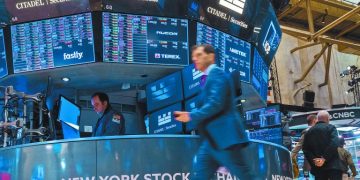The Great Resignation, a term coined to describe the wave of workers leaving their jobs in unprecedented numbers since 2021, has left an indelible mark on the U.S. labor market and, by extension, its financial markets. This shift, which has been a combination of voluntary resignations, retirements, and a re-evaluation of work-life balance, has generated both challenges and opportunities for investors. Understanding how labor shortages are affecting the broader economy is key to grasping the shifting dynamics that investors must navigate. In this article, we will delve deep into the causes and effects of the Great Resignation, how businesses are adapting, the broader implications for inflation and consumer behavior, and expert strategies for investing in a labor-constrained environment.
Analysis of the Ongoing Labor Shortages and the Great Resignation Phenomenon
The Great Resignation began in earnest in 2021, fueled by a combination of factors, including fears of the COVID-19 pandemic, a reevaluation of personal priorities, and the evolving nature of work itself. According to the U.S. Bureau of Labor Statistics, the labor force participation rate in the U.S. saw significant declines during and after the pandemic, with millions of workers choosing to leave their jobs or retire earlier than planned. This phenomenon has left many industries grappling with a lack of workers, especially in sectors such as healthcare, hospitality, retail, and transportation.
At its core, the Great Resignation was not just about people quitting their jobs; it also reflected a fundamental shift in how individuals perceive work. For many, the pandemic was a wake-up call that caused a reevaluation of work-life balance, compensation, and job satisfaction. As remote work became more common, many workers realized they preferred flexible working arrangements or the ability to spend more time with family. Simultaneously, a growing demand for higher wages and better benefits drove workers to seek jobs that offered more financial security or better work conditions.
This disruption to the labor market, however, has not been limited to workers leaving their positions. Retirements have also spiked, further reducing the available workforce. Baby boomers, long the backbone of the U.S. workforce, are retiring at a faster pace than expected, leaving a void in certain industries and contributing to labor shortages in areas like healthcare and skilled trades.

How Businesses and Industries Are Adapting to Changes in the Workforce
With the Great Resignation continuing to affect industries, businesses have been forced to adapt quickly to the changing workforce dynamics. Many companies are implementing strategies to attract and retain talent, such as offering higher wages, enhanced benefits, and more flexible working arrangements. For example, tech companies have led the charge in offering remote work opportunities, with many workers now able to work from home indefinitely, even after the pandemic’s peak.
To mitigate labor shortages, some industries have turned to technology as a solution. Automation, artificial intelligence (AI), and robotics have become critical components in reducing reliance on human labor. In manufacturing, automation has allowed companies to maintain production levels despite labor shortages. Similarly, in retail, the implementation of self-checkout kiosks and AI-driven inventory management systems is helping businesses streamline operations.
Other industries, particularly healthcare, are exploring the gig economy model. As the demand for healthcare workers continues to outstrip supply, hospitals and clinics are turning to contract workers, travel nurses, and temporary staffing solutions to fill gaps. The gig economy is also thriving in sectors like transportation and food delivery, where flexibility in working hours has attracted workers looking for alternative employment opportunities.
In addition to technological advancements, businesses are adjusting their hiring practices to appeal to a broader pool of candidates. Many companies are now offering sign-on bonuses, flexible hours, and remote work options to make their job offerings more attractive. Additionally, businesses are increasingly focused on improving workplace culture and providing better opportunities for career advancement to retain top talent.
Implications for Consumer Spending, Inflation, and Market Performance
The labor shortages resulting from the Great Resignation have had significant effects on the broader U.S. economy, particularly in terms of inflation and consumer spending. As businesses compete for a smaller pool of workers, they are offering higher wages and enhanced benefits. While this helps workers secure better pay, it also leads to higher costs for businesses, which often pass these costs onto consumers in the form of higher prices. This dynamic has contributed to the inflationary pressures felt across the economy, with prices rising on everything from food and housing to gas and healthcare.
Higher wages, though beneficial for workers, can create a feedback loop where rising wages contribute to rising prices, further exacerbating inflation. This scenario presents a unique challenge for the Federal Reserve, which has responded by raising interest rates in an attempt to curb inflation. However, these actions may also have adverse effects on market performance, as higher borrowing costs can dampen consumer spending and reduce investment activity.
The Great Resignation has also influenced consumer behavior in significant ways. With fewer workers available, supply chains have become strained, leading to delays in goods production and delivery. As a result, consumers are faced with higher prices and longer wait times for goods, which may affect their purchasing decisions. On the other hand, the labor shortages have led to increased demand in certain sectors, such as technology and healthcare, which has resulted in growth opportunities for investors in these industries.
Furthermore, the labor shortage’s impact on supply chains and production costs has led to volatility in certain sectors of the market. For example, industries that rely heavily on low-wage workers, such as restaurants and retail, have struggled to maintain profitability. Conversely, sectors that can leverage technology to automate tasks or those that have seen increased demand due to the pandemic, such as e-commerce and logistics, have experienced significant growth.
Expert Strategies for Investing in a Labor-Restrained Economy
In a labor-restrained economy, investors must adjust their strategies to navigate the evolving landscape. For those looking to capitalize on the Great Resignation and its effects on markets, there are several key strategies to consider:
- Invest in Automation and Technology Automation is playing an increasingly important role in many industries, particularly those that are facing labor shortages. Companies that are investing in AI, robotics, and automation technologies offer significant growth potential for investors. Sectors such as manufacturing, logistics, and even retail are leveraging technology to offset the impact of labor shortages. Investors should look for companies with a strong technological edge and a clear strategy for automation in their operations.
- Focus on Growth Industries Certain sectors are benefiting more than others from the labor shortages. Technology, healthcare, and e-commerce are three sectors that have seen significant growth, and they offer attractive investment opportunities. As businesses in these sectors expand to meet growing demand, investors should consider focusing on companies within these industries that are well-positioned for future growth.
- Diversify Across Multiple Sectors The Great Resignation has caused disruptions across many industries, and no sector is completely immune to its effects. Investors should consider diversifying their portfolios to reduce risk and take advantage of opportunities in various sectors. For example, while tech stocks may be performing well, the healthcare sector may offer strong growth potential as the aging population requires more services.
- Look for Companies with Strong Retention Strategies In a labor-constrained economy, retaining talent is just as important as attracting it. Companies that have strong employee retention strategies, such as offering competitive wages, work-life balance, and career development opportunities, are likely to perform better in the long run. Investors should look for companies with a proven track record of employee satisfaction and low turnover rates.
- Monitor Inflation and Interest Rates As inflation rises and the Federal Reserve raises interest rates to curb inflationary pressures, investors should keep a close eye on how these factors are affecting market performance. Interest rate hikes can increase borrowing costs and dampen consumer spending, which may affect corporate profits. Therefore, it is important for investors to adjust their strategies accordingly and focus on sectors that are less sensitive to interest rate changes, such as utilities and consumer staples.
In conclusion, the Great Resignation has reshaped the U.S. labor market and had significant effects on consumer behavior, inflation, and market performance. As businesses adapt to a labor-constrained economy by embracing technology, offering better pay and benefits, and adjusting their hiring practices, investors must also adjust their strategies to capitalize on new opportunities. By focusing on automation, growth industries, and companies with strong retention strategies, investors can position themselves to navigate the challenges and capitalize on the changes brought about by the Great Resignation.





































